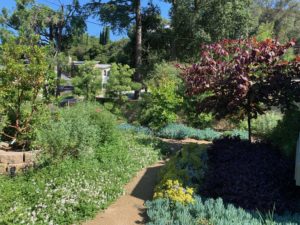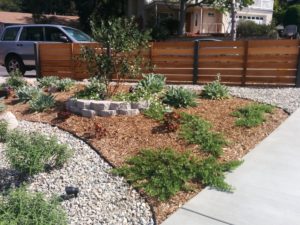Low Water Use Landscapes in Southern California
Is it possible to have a great looking landscape that only gets watered a few times a month? Yes, absolutely, and some landscapes will require even less than that. Welcome to the world of drip irrigation and climate appropriate planting.
Although many low water use properties have a desert aesthetic (decomposed granite, cacti, boulders, etc…), there can be a range of looks, including Southern California chaparral.

Low water use landscapes are no deterrent to beauty
First off, ground cover (wood bark mulch, gravel) will help weed abatement and soil moisture retention. This is perhaps the single most beneficial thing you can do for your landscape. It looks great, adds continuity throughout the yard, and reduces the amount of irrigation needed by reducing the level of evaporation from the soil.
Southern California low water use gardens, once established, can potentially go without any supplemental irrigation during the rainy season, and once a month for the rest of the year. Some of the plants might start to look a little drought stressed in the summer and early fall, but that does not mean they are dying.
You can give them a little water to improve their look, but not too much. Light watering is key. These plants will be damaged if their roots are kept in soggy soil. This creates an environment where pathogens and harmful fungi can grow. Certain trees, such as coast live oaks, should not have any supplemental irrigation at all. They are made for the dry Southern California weather.

A verdant, established low water use landscape
Plants that need more water should be planted in naturally moist areas of the landscape – depressions, low levels, or shaded areas. By creating catch basins and sunken areas in your landscape, rainfall and irrigation will be naturally retained for use by the surrounding plants. Plants that can go longer without water should be placed in drier areas of the yard (higher elevations, more direct sunlight).
Even in very low water landscapes, new plants will need regular watering while they get established. This period will last from a few months to a year. It is important to remember that your water bill will go down significantly once the plants are established.
During the rainy season (generally December through March) you can turn your irrigation completely off. These very low water landscapes look great, thrive in our climate, and help to bring your water bill down.
Drip Irrigation
Indeed, water efficiency is the name of the game here in Southern California. Any well designed and built irrigation system will be water efficient, however, drip irrigation, with its targeted watering, is often the most efficient watering source for planters.

A well designed and built drip system can even water slopes
Drip irrigation uses polyethylene tubing that places water over the plants’ root zones. The water drips out (hence the name) via emitters either embedded in the tubing or attached to it. This type of irrigation goes directly to the soil, minimizing surface evaporation. It is important to put a layer of mulch over all drip lines. The mulch protects the lines from foot traffic, sun, and exposure damage. The mulch cover also increases soil moisture retention. Drip lines and mulch go hand in hand. If you see exposed drip lines out there in the world, it’s being done incorrectly.
Drip irrigation is designed for use in planters, not lawns. Whether it is for low water use shrubs or fruit trees, a properly designed drip irrigation system will efficiently water your plants, equaling healthy greenery and a lower water bill.
Low water irrigation components:
- Micro and shrub sprinklers for perennial plants. These are much like conventional sprinklers for lawns, however, generally, their position is fixed (they do not ‘pop up’), and they emit less gallons per minute.
- Surface drip irrigation – irrigation lines that have water emitters placing targeted water near shrubs. These lines should be covered with mulch. Mulch protects the lines from sun, animal, and foot damage, but it also helps maximize the efficiency of the water output by increasing soil moisture retention.
- PVC lines – these are the life lines that bring water from the main irrigation line out to the sprinklers or drip lines.
- Irrigation Controllers –the brains of the irrigation system. They control when, where, and for how long the water comes on. A properly set irrigation controller is a must for all water efficient landscapes.

A properly maintained drip system will keep your plants healthy while remaining out of sight.
These are the main irrigation types found in residential and non agrarian commercial landscapes. A properly designed and built irrigation system is complex, but the payoff is immense, water-wise, and therefore, money-wise. Contact us today to find out more about what Creative Concepts Landscape can do for your property… and water bill.
Irrigation System Checks & Repairs
Creative Concepts Landscape’s irrigation system checks and repairs will keep your system functioning efficiently, saving your plants and your money.

A low water use landscape highlighting water efficient planting for Southern California
At their most simple level, irrigation systems come in two forms – either you have an automated irrigation system, or you hand water (and hand water frequently). Most people do not have the time or inclination to regularly water their landscape (although playing with a hose is still fun as an adult, just so you know).
So, you have an irrigation system and you keep having problems with it. Or you have an irrigation system and you’re not sure if it’s even working. Your irrigation system, much like the human body, needs to be continually taken care of. With moving water running through it, irrigation systems will slowly (sometimes quickly, unfortunately) come apart.
Contact us and we can schedule an irrigation system check. Our crew will run through and test the entire system. Sometimes only minor adjustments are needed (such as sprinkler nozzle replacements and drip line adjustments), and sometimes we find larger errors, such as malfunctioning valves or controllers, or breaks in an irrigation line.
Irrigation systems, when well built and designed, will bring your landscape to life, and although they will eventually need repairs done, we are here to do that for you. Contact us today to talk about what can be done for your irrigation system!
Creative Concepts Landscape will check your irrigation system (no matter what type is it) and make the needed repairs or installations to create an efficient system for your landscape. Contact us today to find out more.
By Daniel Williams
Client Laison for Creative Concepts Landscape


Planting drought tolerant plants and using less water overall is very important when it comes to summers in Southern California. Great article!
Absolutely! Thank you.
І lіke the helpful info you provide in your articles. I wіll bookmarқ your weblog and
cheⅽk again here frequently. I’m quite sure I’ll learn a lot of new stuff right here!
Best of luck for the next!
Thank you!